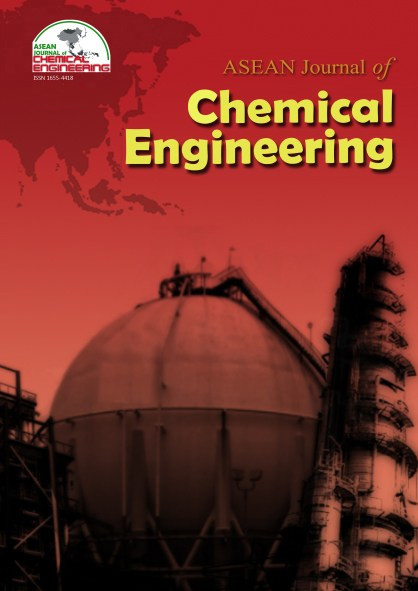Optimization of Defective Coffee Beans Decaffeination Using Palm Oil
Abstract
Defective coffee beans amount to 15-20% of the total produced coffee beans. The defective coffee bean contains caffeine, which can negatively affect the human body, such as increased heart rate, and thus sensitive to consumption by some people. This study aims to optimize the decaffeination process of defective coffee beans. The extraction of aroma and flavor compounds was done by maceration, and the decaffeination was carried out using palm oil as a solvent. The type of beans (green and roasted beans), the decaffeination contact time, and the ratio between coffee bean extract and solvent were varied in this study. The caffeine content was quantified, and the organoleptic and color tests were done on the concentrated coffee extracts. It was found that the higher the amount of solvent volume in decaffeination, the higher the caffeine decrease. In addition, the longer the green beans’ decaffeination time, the lower the caffeine decrease. Decaffeination using green coffee beans resulted in a greater reduction of caffeine (6.515-48.241%) than roasted coffee beans (8.495-24.272%). The optimum operating condition of green coffee bean decaffeination was the coffee bean extract and solvent ratio of 1:5.82 and the decaffeination time of 26.5 minutes. The organoleptic test result shows that decaffeinated coffee flavor had the same preferability as the commercial coffee flavor and was thus able to compete in the market.
References
Amri, A., Fermi, M. I., and Sulistyati, I., 2012. “Modeling, variables influence and optimization using response surface method – central composite design (RSM-CCD) on the sodium lignosulfonate production from.” Reaktor, 12(3), 183–188.
Barbosa, M. de S. G., Scholz, M. B. dos S., Kitzberger, C. S. G., and Benassi, M. de T., 2019. “Correlation between the composition of green Arabica coffee beans and the sensory quality of coffee brews.” Food Chemistry, 292, 275–280.
Bekedam, E. K., 2008. “Coffee Brew Melanoidins. Structural and Functional Properties of Brown-Colored Coffee Compounds.” Ph.D. thesis Wageningen University, The Netherland.
Bruhns, P., Kanzler, C., Degenhardt, A. G., Koch, T. J., and Kroh, L. W., 2019. “Basic structure of melanoidins formed in the Maillard reaction of 3-deoxyglucosone and γ-aminobutyric acid.” Journal of Agricultural and Food Chemistry, 67(18), 5197–5203.
Del Castillo, M. D., Ames, J. M., & Gordon, M. H, 2002. “Effect of roasting on the antioxidant activity of coffee brews.” Journal of Agricultural and Food Chemistry, 50(13), 3698–3703.
Fibrianto, K., Umam, K., and Shinta Wulandari, E. 2018. “Effect of roasting profiles and brewing methods on the characteristics of Bali Kintamani coffee.” Advances in Engineering Research, 172, 194–197.
Franca, A. S., and Oliveira, L. S, 2008. Chemistry of defective coffee beans. Food Chemistry Research Developments. USA: Nova Science Publishers, Inc.
Gotteman, M., 1985. Decaffeination of Green Coffee with N-Butyl Acetate. US Patent No. 4,562,083.
Hossain, Md M and Wei E.C., 2011. A New Approach for Removal of Caffeine Using Sunflower Oil. Proceedings of the World Congress of Engineering 2011 Vol. III., London, U.K.
Kartasasmita, E.R, and Susan, A, 2012. “Dekafeinasi biji robusta (Coffea canephora L.) menggunakan pelarut polar (etanol dan metanol).” Acta Pharmaceutica Indonesia, 37(3), 83-89.
Langner, E., and Rzeski, W., 2014. “Biological properties of melanoidins: A review.” International Journal of Food" Properties, 17(2), 344–353.
Lyman, D. J. Benck, R. Dell, S. Merle, S. and Murray-Wijelath, J, 2003. “FTIR-ATR analysis of brewed coffee: effect of roasting conditions.” Journal of Agricultural and Food Chemistry 51(11), 3268-3272
McCabe, W. L., Smith, J. C., and Harriott, P., 1993. Unit operations of chemical engineering (5th ed.). McGraw-Hill, USA
Mossine, V. V., & Mawhinney, T. P., 2010. 1-amino-1-deoxy-d-fructose (“fructosamine”) and its Derivatives. In Advances in Carbohydrate Chemistry and Biochemistry (Vol. 64, Issue C). Elsevier Inc.
Ngugi, K., Cheserek, J., and Omondi, C., 2021. Organoleptic, Sensory and Biochemical Traits of Arabica Coffee and their Arabusta Hybrids. IntechOpen. Doi: 10.5772/intechopen.95520.
Pérez-Hernández, L. M., Chávez-Quiroz, K., Medina-Juárez, L. Á., & Gámez Meza, N., 2012. “Phenolic characterization, melanoidins, and antioxidant activity of some commercial coffees from Coffea arabica and Coffea canephora.” Journal of the Mexican Chemical Society, 56(4), 430–435.
Pietsch, A., 2017. Decaffeination-Process and Quality. The Craft and Science of Coffee, Britta Folmer (ed). Academic Press, Massachusetts, USA
Reyes, C.M., and Marilyn C. C., 2018. “Caffeine in the diet: country-level consumption and guidelines. Nutrients.” Nutrients, 10(11),1772
Shofinita, D., Lestari, D., Aliwarga, L., Sumampouw, G.A., Ambarwati, S.A., Gunawan, K.C. and Achmadi, A.B., 2023. “Drying methods of coffee extracts and their effects on physicochemical properties: A review.” Food and Bioprocess Technology, pp.1-26. https://doi.org/10.1007/s11947-023-03067-4
Widagdyo, D. R. W., Velina Agustien, B., Aylianawati, and Indraswati, N., 2013. “Ekstraksi kafeina dari serbuk kopi.” Teknik, 12(1), 1–10.
Wulandari, A., Rustiani, E., Noorlaela, E. and Agustina, P., 2019. “Formulasi ekstrak dan biji kopi robusta dalam sediaan masker gel peel-off untuk meningkatkan kelembaban dan kehalusan kulit.” FITOFARMAKA: Jurnal Ilmiah Farmasi, 9(2), 77-85.
Zabot, G. L., 2019. Decaffeination Using Supercritical Carbon Dioxide. Elsevier Inc., https://doi.org/10.1016/B978-0-12-817388-6.00011-8.
Copyright holder for articles is ASEAN Journal of Chemical Engineering. Articles published in ASEAN J. Chem. Eng. are distributed under a Creative Commons Attribution-NonCommercial 4.0 International (CC BY-NC 4.0) license.
Authors agree to transfer all copyright rights in and to the above work to the ASEAN Journal of Chemical Engineering Editorial Board so that the Editorial Board shall have the right to publish the work for non-profit use in any media or form. In return, authors retain: (1) all proprietary rights other than copyright; (2) re-use of all or part of the above paper in their other work; (3) right to reproduce or authorize others to reproduce the above paper for authors’ personal use or for company use if the source and the journal copyright notice is indicated, and if the reproduction is not made for the purpose of sale.



